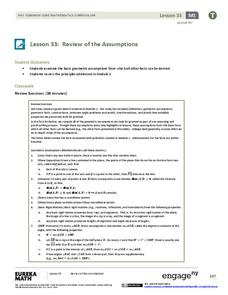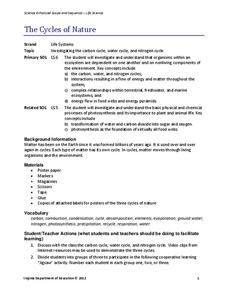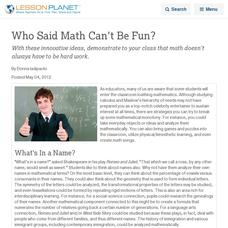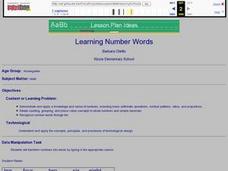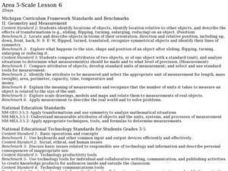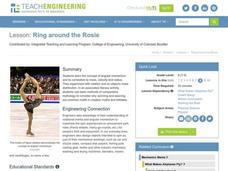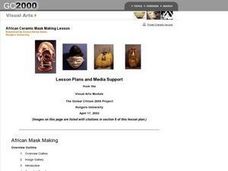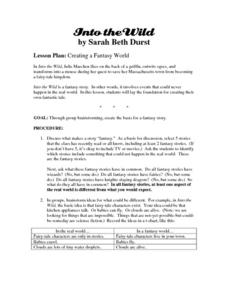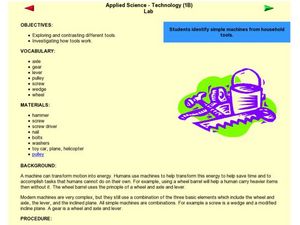EngageNY
Review of the Assumptions (part 1)
What was the property again? Tired of hearing this from your pupils? Use this table to organize properties studied and as a reference tool for individuals. Learners apply each property in the third column of the table to ensure their...
Virginia Department of Education
The Cycles of Nature
Encourage peer collaboration and assist with the creation of visual aids to identify carbon, water, and nitrogen cycles as your class learns more about nature. They discuss relative information, create a visual aid...
Virginia Department of Education
Inductive and Deductive Reasoning
Introduce pupils to the two types of reasoning, inductive and deductive. Classmates work in pairs or small groups to learn the difference between the two and apply these reasonings to develop valid conclusions.
Curated OER
Who Said Math Can't Be Fun?
With these innovative ideas, demonstrate to your class that math doesn't always have to be hard work.
Curated OER
Linear Piecewise Functions
Students explore the concept of piecewise functions. In this piecewise functions lesson, students graph piecewise functions by hand and find the domain and range. Students make tables of values given a piecewise function. Students write...
Curated OER
Coordinate Plane
Students use computer applets to demonstrate three dimensional coordinate planes. In this coordinate planes lesson plan, students play a coordinate game and a maze game.
Curated OER
Top Quark Lab
Students find the mass of the top quark. In this physics lesson, students create a vector diagram from a given set of data. They discuss their calculations and findings in class.
Curated OER
Farming 1: Farming Machines
Second graders explore different farm machines. In this farm lesson, 2nd graders discover the importance of farmers, and crops. Students discuss healthy eating and how crops are packaged. Students read books about farms and how bread is...
Curated OER
Property Lists for Quadrilaterals
Students establish classifications of shapes by various properties (angles, sides, etc.). They introduce the important properties of common shapes. Students develop an awareness of the wide variety of ways the 2-D shapes can be alike.
Curated OER
DNA. RNA, and Proteins
A comprehensive five-page quiz or study guide covering DNA and its related processes. Young geneticists will need a strong understanding in order to complete this handout, which includes multiple choice, matching, compare/contrast, and...
Curated OER
Learning Number Words
Students practice saying their numbers and identifying the words. They use whole numbers and decimals to practice grouping numbers into different categories. They write the word of the number they are shown.
Curated OER
Electricity and Magnetism: From Fun to Function
Fourth graders experiment with electricity and magnetism and build an electromagnetic motor. In this electromagnetism lesson, 4th graders use household objects to show electrostatics and magnets and compasses to show magnetism. They...
Curated OER
Changing Crust
In this changing crust worksheet, learners use candy bars, licorice sticks and bubble gum to simulate the 3 types of forces that change the Earth's crust. These include compressional forces, tensional forces and transversal forces. The...
Curated OER
Scaled Rubber Band Drawings
Students demonstrate the process of creating a scaled rubber band enlargement of a simple drawing. They observe and discuss a teacher-led demonstration, and create a scaled rubber band enlargement of simple drawings and their invention...
Curated OER
With Liberty and Justice for All
Students examine the role of Supreme Court justices. In this judicial branch lesson, students consider the civil rights and civil liberties as they investigate Minersville School District v. Gobitis (1940) and West Virginia State Board...
Curated OER
Properties of Logarithms
Students explore the concept of logarithms. In this logarithms lesson, students discuss the logarithm properties. Students use linear functions as a basis to develop the logarithm properites by substituting log b and log a...
Curated OER
Packaging and Transport
Students examine the methods by which food is packaged and transported to their dinner tables. For this packaging and transporting lesson plan, students explore how machines help people grow food. Students also obtain knowledge about how...
Curated OER
Introducing Tessellations
Students create tessellations to increase their knowledge of the applications of geometry. They explore the different shapes of polygons.
Curated OER
Ring Around the Rosie
Learners examine the concept of angular momentum and its correlation to mass, velocity, and radius. They listen to a teacher-led lecture, conduct an experiment with rotational inertia, angular momentum, and rotation speed by making...
Curated OER
African Ceramic Mask Making
Students investigate a variety of African mask types, design several masks, and create an example of an African ceramic mask in this 5th grade through High School Art lesson. The lesson can take anywhere from 6 lessons to 16 lessons.
Curated OER
Nursery Rhyme Modernization
Students retell a nursery rhyme updating it and create a video. In this Movie Maker nursery rhyme lesson, students use technology to update a nursery rhyme. Students incorporate special effects, actions, and captured...
Curated OER
Creating a Fantasy World
Students create the basis for a fantasy story. They discuss what makes a story "fantasy" and identify which stories include something that could not happen in the real world. They determine what these fantasy stories have in common.
Curated OER
Butterfly Lifecycles
What a great way to present this topic! While a little difficult to follow, this lesson provides great ideas for a second grade lesson involving butterfly lifecycles. Learners make drawings of butterflies, discuss life cycles, and write...
Curated OER
Household Tools
Students explore parts of a system. In this simple machines lesson, students discover that simple machines are composed of two or more systems. Students examine household tools and assess the parts of the system.
